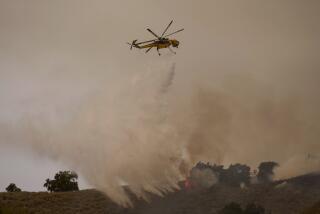Op-Ed: Treat wildfires like other natural disasters
More than 10 million acres of forest burned in 2015, the worst year for U.S. wildfires ever recorded. With incredibly dry conditions across the American West, fire lines were intensely hot and flames spread faster, producing some of the most dangerous conditions firefighters have ever seen.
In the face of climate change and drought, longer and more severe fire seasons are to be expected. But last year the United States also suffered more catastrophic fires. These fires are natural disasters, as destructive as many hurricanes, tornadoes or floods. But that’s not how the federal government treats them, or pays for them.
Outdated budget rules require the U.S. Forest Service to fight [fires] by diverting funds from other parts of its budget -- including fire prevention programs.
California’s 2015 fire season, for instance, included blazes that ranked among the most destructive in state history. The Valley fire in Lake, Napa and Sonoma counties burned 50,000 acres in just one day and 76,000 acres total. It killed four people and destroyed 1,958 homes and other buildings. The Butte fire burned more than 70,000 acres in Amador and Calaveras counties, killed two people and destroyed 1,293 structures. The Rough fire, the year’s largest, burned 150,000 acres in Fresno County. Nearly 4,000 firefighters were deployed to contain that blaze.
If it had been massive storms that caused such extraordinary devastation, and their costs outstripped the budget for disaster response, the Federal Emergency Management Agency and other agencies could access additional federal funding to pay for cleanup and recovery. In contrast, wildfire response remains subject to strict spending limits, regardless of a fire’s severity. Worse, outdated budget rules require the U.S. Forest Service to fight these fires by diverting funds from other parts of its budget — including fire prevention programs that remove dead trees and brush from forests.
This shortsighted practice means that as the Forest Service spends more on combating huge fires, it has less to spend on preventing them. States get hamstrung as a result too. California, for instance, shares responsibility with the Forest Service for maintaining public lands, but state, federal and private acreage are intertwined throughout the state. California’s efforts to clear brush in its sections of forest are less effective if the federal government doesn’t also clear its sections. Wildfires, after all, don’t stop at jurisdictional boundaries.
And California’s forests need urgent attention. About 888 million acres have suffered substantial water loss. More than 29 million trees have died as a result of the drought and pests. Removing dead trees from national forests and parks is a formidable task, and the Forest Service cannot be an effective partner unless it has the budget to invest in long-term wildfire prevention efforts.
The agency must be allowed to pay for fighting extraordinary wildfires similarly to how FEMA and other agencies pay for disaster responses. The response to Hurricane Sandy did not come at the expense of routine maintenance on levees to prevent future floods. Likewise, the Forest Service’s firefighting costs should not come at the expense of routine brush clearance and maintenance that help prevent future wildfires.
Democrats and Republicans in both houses of Congress agree that this problem needs fixing. Last year’s Senate version of the appropriations bill to fund the Forest Service provided a simple solution: It would have allowed the agency to access a separate stream of federal funds, unconstrained by government-wide spending limits, to combat wildfires during an above-average fire season.
This concept has broad, bipartisan support. It has been included in other proposals from members of Congress who represent Western states and is supported by the Obama administration.
Despite that consensus, the fix was not included in the spending bill passed last December because some lawmakers requested additional reforms related the Forest Service’s long-term budget outlook, while others requested contentious changes to how the agency manages national forests and conducts environmental reviews.
Congress should pursue comprehensive reforms to make it easier to care for the nation’s forests — but there simply is no bipartisan agreement on those latter issues. This unnecessary gridlock is preventing the budget fix from passing.
Robbing fire prevention accounts to fight fires makes no sense and needs to end as soon as possible. A straightforward, narrow fix to the federal wildfire budgeting process is uncontroversial and needed urgently. Congress should pass the budget fix on its own now and buy time to find consensus on broad reforms.
California can’t wait until the height of fire season this summer to clear dry brush and dead trees from our forestland. Wildfires are deadly disasters, and Congress needs to treat them as such.
Dianne Feinstein is the senior senator from California. Ken Pimlott is the director of Cal Fire and California’s state forester.
Follow the Opinion section on Twitter @latimesopinion and Facebook
More to Read
A cure for the common opinion
Get thought-provoking perspectives with our weekly newsletter.
You may occasionally receive promotional content from the Los Angeles Times.










